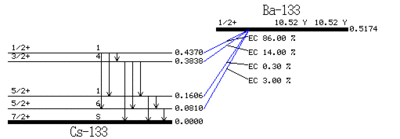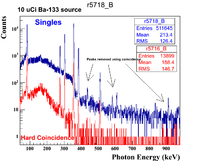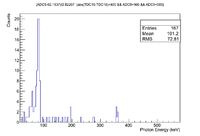R5718-5716 Ba133Analysis
Ba-133 source lines
Ba-133 undergoes electron capture to Cs-133. 86% of the time it ends up in the 1/2+ , 437 keV excited state of Cs-133.
| Energy(keV) | Intensity(rel) |
| 53.1625( 6) | 2.199(22) |
| 79.6139(13) | 2.62( 6) |
| 80.9971(12) | 34.06(27) |
| 160.6109(17) | 0.645( 8) |
| 223.2373(14) | 0.450( 4) |
| 276.3997(13) | 7.164(22) |
| 302.8510( 6) | 18.33( 6) |
| 356.0134( 6) | 62.05(19) |
| 383.8480(12) | 8.94( 3) |
Run list
| Run | Description | |
| 5716 | Coincidences for Ba-133 10 uCi source. The CFD widths were 10 nsec making the coincidence window 20 nsec. running time 7 hrs , 33 min, 14sec. Rate was 1 Hz | |
| 5718 | Logic Unit in OR mode for Ba-133 10 uCi source. The CFD widths were 10 nsec making the coincidence window 20 nsec. running time 2 min, 5 sec. Rate was 4 kHz |
Singles Run 5718 Analysis
Photons from the source
ntuple->Draw("(ADC5-62.1537)/2.82207 >>(4096,0,4096)")
ntuple->Draw("(ADC9-39.8)/2.61747 >>(4096,0,4096)")
Did not observe the 53,79,160, 223, lines
| Photon Energy (keV) | Description |
| 82 | Strong, probably the 80.9971 line from the 5/2+ to 7/2+ Cs-133 transition |
| 277 | Medium, probably the 276.3997 line from the 1/2+(437 keV) to the 5/2+ (161 keV) Cs-133 transition |
| 303 | Medium, probably the 302.8510 line from the 3/2+(383 keV) to 5/2+ (81 keV) Cs-133 transition |
| 356 | Strong, likely the 356.0134 line from the 1/2+(437 keV) to 5/2+ (81 keV) Cs-133 transition |
| 384 | Medium, likely the 383.8480 line from the 3/2+ (383 keV) excited state of Cs-133 to the ground state |
| 437 | |
| 510 | Weak |
| 584 | |
| 609 | |
| 911 | |
| 1121 | |
| 1277 | Possibly Na-22 there is a 511 keV line. |
| 1460 | Possibly Eu-148 or Tm-168. Eu-148 has a very strong line at 630 keV and 550 keV but it is not seen. Tm-168 has a strong line at 731 but this is not observed. |
Coincidence Run 5716 Analysis
| Coincidence (decay time in seconds) | |
| 53.1622 | 79.6142 (2.16E-10), 80.9979 (6.49E-9), 160.6120 (2.16E-10), 223.2368 (4.39E-11), 302.8508 (4.39E-11), 383.8485 (4.39E-11) |
| 79.6142 | 53.1622 (2.16E-10), 80.9979 (6.28E-9), 223.2368 (1.72E-10), 276.3989 (1.72E-10) |
| 80.9979 | 53.1622 (6.49E-9), 79.6142 (6.28E-9), 223.2368 (6.45E-9), 276.3989 (6.45E-9), 302.8508 (6.28E-9), 356.0129 (6.28E-9) |
| 160.6120 | 53.1622 (2.16E-10), 223.2368 (1.72E-10), 276.3989 (1.72E-10) |
| 223.2368 | 53.1622 (4.39E-11), 79.6142 (1.72E-10), 80.9979 (6.45E-9), 160.6120 (1.72E-10) |
| 276.3989 | 79.6142 (1.72E-10), 80.9979 (6.45E-9), 160.6120 (1.72E-10) |
| 302.8508 | 53.1622 (4.39E-11), 80.9979 (6.28E-9) |
| 356.0129 | 80.9979 (6.28E-9) |
| 383.8485 | 53.1622 (4.39E-11) |
The 81 keV and 356 keV lines are the strongest and, when they occur in coincidence, represent the transition from the 436 keV excited state of Cs-133 to the 81 keV excited state and then the ground state.
If I put a cut on the strongest line (356 keV) and ask what photon energies are observed in coincidence with the other HpGe detector I see the spectrum
The 83, 276, 302, and 356 lines are observed when a 200 nsec coincidence window is required.
276.3997(13) 7.164(22)
302.8510( 6) 18.33( 6) 356.0134( 6) 62.05(19)
- 276 && 306 keV lines http://www.nndc.bnl.gov/nsr/nsrlink.jsp?1995JU02
- Ba-132 83 && 360 http://www.nndc.bnl.gov/nsr/nsrlink.jsp?1996KU01 http://www.nndc.bnl.gov/nsr/nsrlink.jsp?2002GA01
- Ba-132 383 && 515 http://www.nndc.bnl.gov/nsr/nsrlink.jsp?1975GI11


